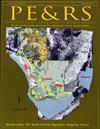利用植被偏振测量反演太阳诱导的叶绿素荧光
IF 2
4区 地球科学
Q4 GEOGRAPHY, PHYSICAL
引用次数: 0
摘要
在植被遥感中,植被冠层的视辐射通常与来自植被不同部位、具有不同产生机制和光学性质的三个分量相结合:体积散射Lvol、偏振光Lpol和叶绿素荧光ChlF。叶绿素荧光在植被遥感中起着非常重要的作用,植被遥感中的极化信息已成为表征植被物理特征的有效手段。本研究分析了这三种辐射通量的差异,并利用极化辐射将其与植被冠层的视辐射分离。具体来说,利用标准弗劳恩霍夫线判别法从植被冠层辐射数据中提取太阳诱导的叶绿素荧光。结果表明,偏振测量可以定量分离Lvol、Lpol和ChlF,并提取太阳诱导的叶绿素荧光。该研究提高了我们对植被冠层光散射特性的理解,并为开发建筑模型和研究算法提供了见解。本文章由计算机程序翻译,如有差异,请以英文原文为准。
Inversion of Solar-Induced Chlorophyll Fluorescence Using Polarization Measurements of Vegetation
In vegetation remote sensing, the apparent radiation of the vegetation canopy is often combined with three components derived from different parts of vegetation that have different production mechanisms and optical properties: volume scattering Lvol, polarized light Lpol,
and chlorophyll fluorescence ChlF. The chlorophyll fluorescence plays a very important role in vegetation remote sensing, and the polarization information in vegetation remote sensing has become an effective way to characterize the physical characteristics of vegetation. This study analyzes
the difference between these three types of radiation flux and utilizes polarization radiation to separate them from the apparent radiation of the vegetation canopy. Specifically, solar-induced chlorophyll fluorescence is extracted from vegetation canopy radiation data using standard Fraunhofer-line
discrimination. The results show that polarization measurements can quantitatively separate Lvol, Lpol, and ChlF and extract the solar-induced chlorophyll fluorescence. This study improves our understanding of the light-scattering properties of vegetation canopies and
provides insights for developing building models and research algorithms.
求助全文
通过发布文献求助,成功后即可免费获取论文全文。
去求助
来源期刊

Photogrammetric Engineering and Remote Sensing
地学-成像科学与照相技术
CiteScore
1.70
自引率
15.40%
发文量
89
审稿时长
9 months
期刊介绍:
Photogrammetric Engineering & Remote Sensing commonly referred to as PE&RS, is the official journal of imaging and geospatial information science and technology. Included in the journal on a regular basis are highlight articles such as the popular columns “Grids & Datums” and “Mapping Matters” and peer reviewed technical papers.
We publish thousands of documents, reports, codes, and informational articles in and about the industries relating to Geospatial Sciences, Remote Sensing, Photogrammetry and other imaging sciences.
 求助内容:
求助内容: 应助结果提醒方式:
应助结果提醒方式:


